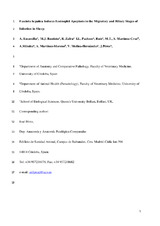Fasciola hepatica induces eosinophil apoptosis in the migratory and biliary stages of infection in sheep
Autor
Escamilla, Alejandro
Bautista Pérez, María José
Zafra Leva, Rafael
Pacheco, I.L.
Ruiz, M.Teresa
Martínez Cruz, Setefilla
Méndez, A.
Martínez-Moreno, Álvaro
Molina Hernández, Verónica
Pérez, José
Editor
ElsevierFecha
2016Materia
ApoptosisCaspase-3
Eosinophil
Fasciola hepatica
Sheep
METS:
Mostrar el registro METSPREMIS:
Mostrar el registro PREMISMetadatos
Mostrar el registro completo del ítemResumen
The aim of the present work was to evaluate the number of apoptotic eosinophils in the livers of sheep experimentally infected with Fasciola hepatica during the migratory and biliary stages of infection. Four groups (n = 5) of sheep were used; groups 1–3 were orally infected with 200 metacercariae (mc) and sacrificed at 8 and 28 days post-infection (dpi), and 17 weeks post-infection (wpi), respectively. Group 4 was used as an uninfected control. Apoptosis was detected using immunohistochemistry with a polyclonal antibody against anti-active caspase-3, and transmission electron microscopy (TEM). Eosinophils were identified using the Hansel stain in serial sections for caspase-3, and by ultrastructural features using TEM. At 8 and 28 dpi, numerous caspase-3+ eosinophils were mainly found at the periphery of acute hepatic necrotic foci. The percentage of caspase -3+ apoptotic eosinophils in the periphery of necrotic foci was high (46.1–53.9) at 8 and 28 dpi, respectively, and decreased in granulomas found at 28 dpi (6%). Transmission electron microscopy confirmed the presence of apoptotic eosinophils in hepatic lesions at 8 and 28 dpi. At 17 wpi, apoptotic eosinophils were detected in the infiltrate surrounding some enlarged bile ducts containing adult flukes. This is the first report of apoptosis induced by F. hepatica in sheep and the first study reporting apoptosis in eosinophils in hepatic inflammatory infiltrates in vivo. The high number of apoptotic eosinophils in acute necrotic tracts during the migratory and biliary stages of infection suggests that eosinophil apoptosis may play a role in F. hepatica survival during different stages of infection.

